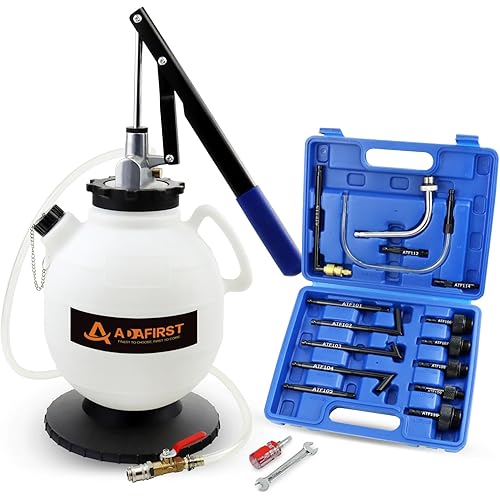Mityvac 7201 Manual Fluid Evacuator Plus with 2.3 Gallon Reservoir; Evacuates or Dispenses Fluids with Push Button; Evacuate Through The Dipstick Tube










Buy Now, Pay Later
- – 6-month term
- – No impact on credit
- – Instant approval decision
- – Secure and straightforward checkout
Ready to go? Add this product to your cart and select a plan during checkout.
Payment plans are offered through our trusted finance partners Klarna, Affirm, Afterpay, Apple Pay, and PayTomorrow. No-credit-needed leasing options through Acima may also be available at checkout.
Learn more about financing & leasing here.
30-day refund/replacement
To qualify for a full refund, items must be returned in their original, unused condition. If an item is returned in a used, damaged, or materially different state, you may be granted a partial refund.
To initiate a return, please visit our Returns Center.
View our full returns policy here.
Recently Viewed
Features
- Features a large 8.8 liter (2.3 gallon) capacity bi-functional manual unit to extract and dispense a wide-range of fluid types. It includes accessories for draining engine oil or transmission fluid directly through the dipstick tubes.
- Clean and simple way to evacuate and dispense fluids
- Reservoir is constructed of durable polyethylene and will not rust or corrode
- Automatic flow control valve prevents the unit from overfilling during use and automatically shuts off at 8 liters
- Features 0.23" OD x 5' long (5.7 mm OD x 1.5 m long) dipstick tube, 0.26" OD x 5' long (6.6 mm OD x 1.5 m long) dipstick tube, 0.41" OD x 5' long (10 mm OD x 1.5 m long) main evacuation tube
Description
The Mityvac 7201 2.3 Gallon Fluid Evacuator Extractor and Dispensing Pump is a versatile tool designed for efficient fluid management in automotive and industrial settings. It supports both fluid extraction and dispensing, making it ideal for tasks like oil changes, coolant refills, and transmission fluid removal. With its manual push-button operation, it provides precise control. Constructed from chemical-resistant polyethylene, it's built for durability. Key features include an automatic overflow prevention system and a quick-drain spout. Its compact, lightweight design ensures easy transport, making it suitable for various vehicles and industrial applications.
Brand: Mityvac
Special Feature: Bi-functional (extract and dispense)
Product Dimensions: 9.3"L x 13.2"W x 25.4"H
Package Information: Tube
Item Weight: 11.7 Pounds
Model Name: MV7201
UPC:
Global Trade Identification Number: 29, 12
Manufacturer: Mityvac
Global Trade Identification Number: 29, 12
Manufacturer: Mityvac
Model Number: 7201
UPC: 646541003829 782386215420 646541000712 031113169056 012951615011 765042369002
Brand: Mityvac
Built-In Media: Unit^Instruction Guide
Model Name: MV7201
Capacity: 8.8 Liters
Item Weight: 11.7 Pounds
Item Dimensions L x W x H: 9.3"L x 13.2"W x 25.4"H
Purification Method: Hollow Fiber Membrane, Ultra Filtration
Additional Features: Bi-functional (extract and dispense)
Container Type: Tube
Material Type: HAWA
Frequently asked questions
To initiate a return, please visit our Returns Center.
View our full returns policy here.
- Klarna Financing
- Affirm Pay in 4
- Affirm Financing
- Afterpay Financing
- PayTomorrow Financing
- Financing through Apple Pay
Learn more about financing & leasing here.
Similar Products
Top Amazon Reviews

























